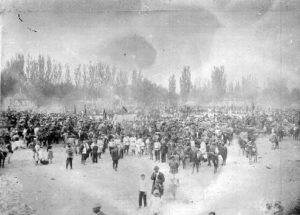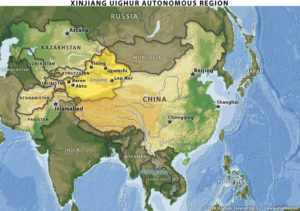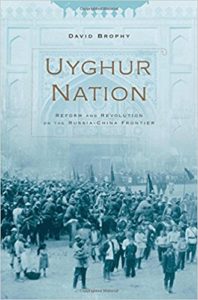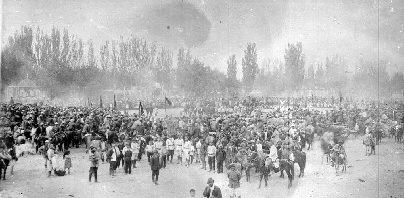The following interview is part of a year-long series LeftEast is running exploring the impact of the Russian Revolution in Eastern Europe and Eurasia. Over the course of this anniversary year we will publish historical documents, interviews and articles reflecting on the role of 1917 in reshaping the political horizons of the region.
David Brophy is Senior Lecturer in Modern Chinese History at the University of Sydney whose work explores the history of modern Uyghur nationalism as it emerged in the context of imperial competition, reform and revolution in Russian and Chinese Turkistan. LeftEast’s James Robertson spoke with Brophy on the effects of the Russian Revolution in Central Asia, the role of the imperial periphery in shaping early Soviet policy and the legacy of 1917 for the region today.
Robertson: Your book is, in large measure, a history of the birth of a modern Uyghur nationalism. But that way of characterizing it also narrows the broader view it takes on the history of the idea of being “Uyghur”. Rather than a straightforward narrative of the emergence of Uyghur nationalism, you instead prefer the term “uyghurist politics.” Can you say a little about what you mean by that? What is “uyghurist politics” and how does it relate to the birth of modern Uyghur nationalism?
Brophy: You’re right, in many ways these are two quite different things. Or we could at least say that today’s Uyghur nationalism is only one of the possible threads to emerge from the period I’m interested in in the book. There’s a common way of looking at politics in Eurasia in the early twentieth-century, which says that there were various “pan-” movements (e.g. pan-Turkism, pan-Slavism) on the one hand, alongside particularistic ethno-nationalisms on the other, and people had to pick between them. The case of the Uyghurs shows that that’s really too simple a way of thinking about things.
The construction of a certain narrative of Uyghur history, as the glorious history of a steppe civilization distinct from surrounding Chinese, Slavic, or Iranian civilizations, had wide appeal, and not just among the Turkic-speaking Muslims of western China. Before it came to China, an idealized sense of “Uyghur” history as the history of all civilized Turks became a point of pride for cultural nationalists in Russia and the Ottoman Empire. If events had taken a different course, we might today still think of “Uyghurism” alongside pan-Turkism and Turanism as part of a set of romantic discourses that were inclusive of all the world’s Turkic peoples.

Now, there was a slight difference between the way this thinking was received in the Ottoman Empire and Russia. Most of the Tatar avant-garde preferred to define their political project as “Tatar,” and so they were inclined to see the other Turkic peoples of Russia in similar terms, as members of a Turkic family but with their own distinct identities and histories. That had an influence on how Muslims from China came to lay claim to the Uyghur story for themselves. In Russian Turkistan, even people who were identified as “pan-Turkists” were mainly interested in making something out of Russian, or western Turkistan. Mirroring this, Uyghur, and the accompanying idea of Uyghurstan, became a sort of catch-all cultural rallying point for things Turkic and Muslim associated with Eastern, or Chinese Turkistan.
So “Uyghurism” became politicized in quite a broad and inclusive way initially, more as a tool of alliance building than national imagination. It was capacious enough to rally people who really didn’t think of themselves as ethnic brethren, but who were united by ties to China.
Concretely, Uyghur was the name of a political club founded in Vernyi (now Almaty); in 1921 this merged with organizations of Chinese citizens, to form the “Revolutionary Union of Kashgari and Jungharian Workers – Uyghur.” In a vague sense this was grounded in an idea of common Uyghur genealogy, but for a lot of people in and around this organization, my sense is that being a “Uyghur” was primarily a question of factional identity. In the wake of 1917, the pressure of events meant that working out what was a viable political project took precedence over debating questions of national identity.
Robertson: On this last point, it is worth noting that the events of 1917 are a key turning point in your book. Can you explain what effect the February and October Revolutions had on the peoples of Russian Central Asia? What did the revolutionary years from 1917-24 look like for the Turkic Muslims on the Russian-Chinese borderlands?
Brophy: In Central Asia the revolution really begins in 1916, with an uprising against conscription, followed by reprisals by settlers and soldiers, leading in turn to February and the end of tsarism. I think for most people this was experienced primarily as the collapse of a state, and it was a while before questions of parties and programs became important.
The frontier with China was a particularly violent region. Kazakhs and Kirghiz fled to China, but sedentary migrants from Xinjiang (the so-called Taranchis of Semireche, now SE Kazakhstan) were also victims of the vigilante violence – some of it coming from the Red Army – and many of these ended up crossing into Xinjiang. The Kashgari bazaar traders and seasonal laborers who were Chinese citizens were also facing a serious crisis, and a lot of them lost their wealth to raids or confiscations. The border was officially shut until 1925, so these people found themselves stranded on foreign soil in the middle of a looming Civil War.
Naturally, all this forced people to get organized. Among those who were Soviet citizens, the story fits quite well into the mainstream narrative of the revolution in Central Asia: young, Russian-educated activists moving from pre-revolutionary reformism into the Bolshevik party. Particularly after Lenin’s intervention to sideline the colonialist “old Bolsheviks” in Turkistan, these people were thrust into positions of considerable responsibility. As members of a small minority, the Uyghur activists had less of a stake in the next round of faction-fighting between Muslim Communist leaders and Moscow, so they survived the purge of the party’s Muslim Bureau, and got a foothold in international work.
Among the Chinese-speaking Muslims, the Dungans, the story was a bit different: here the most prominent post-1917 leaders came out of the Red Army. Then you have the Chinese citizens, which to my mind was the most interesting case. Initially this organizing took the form of relief committees, which were part of a network of organizations among Chinese elsewhere in Russia, and only gradually took on a more explicitly Turkic and Muslim coloring. Here, politics largely consisted of a tug of war for influence between Bolshevik-aligned organizations, and a network of quasi-consuls known as aqsaqals, who were answerable to the Chinese authorities back in Xinjiang. It’s a story that’s quite similar to the situation you find among Uyghurs outside China today, with exile political organizations competing for influence alongside networks that are directed by the nearest Chinese consulate or embassy.
So the nature of political conflict in these communities was very much determined by the institutions of control and surveillance that had arisen along the frontier to manage the flow of people and goods. The Bolsheviks provided Chinese-citizen Kashgaris with an alternative to working with these Chinese-appointed officials, but of course, those that chose to do so made themselves enemies in the eyes of the Xinjiang provincial administration, and that pushed them in an increasingly radical direction. For a while, the Soviets experimented with a “revolutionary” citizenship policy, which would allow locally constituted organizations to defend the interests of foreigners, but they soon realized that they could only go so far in that direction without seriously antagonizing the governments of the world.

Robertson: Picking up on this thread of Chinese citizens in revolutionary Turkistan, a lot of the story that you tell in this book is a history of diasporas, of cross-border trading communities and large scale resettlements along imperial borderlands. This obviously inflected the development of modern politics in the region, and ascribed particular importance to emigre communities. How did the mobility of people and groups shape Soviet policy in the region? What possibilities did it offer, for example, in spreading the revolution beyond the old imperial borders?
Brophy: For the first half of the 1920s at least, mobility was a good thing in Soviet eyes. It’s important to keep in mind, though, that this was a border with an empire, not with a nation state. So the Bolsheviks had to deal with the question of how to approach a multi-ethnic empire as revolutionaries. That is to say, how would the distinct pieces of the empire fit into some kind of strategy towards the whole? To sum up what was a complicated debate, the Comintern tended to be quite gung-ho towards Xinjiang, while the diplomats in the NKID were more interested in securing diplomatic recognition from China, and so were skeptical about the value of agitation in Xinjiang.
For the first few years, the situation along the frontier was more or less a political free-for-all. As long as the Comintern was pursuing an alliance with Muslim nationalists in the Middle East, they tended to treat Xinjiang as part of the Islamic world. The province fell within the purview of the Turkistan Bureau of the Comintern, and in 1921 this bureau sent a proposal to Sovietize Xinjiang to the Bolshevik Central Committee. (Trotsky argued against it, and won the debate). This approach came to an end in late 1921, when the Bolshevik alliance with the ex-Turkish C-in-C Enver Pasha backfired badly, and leaders of the “Uyghur” Revolutionary Union were implicated in his anti-Bolshevik turn.
In the next few years, for anyone still hoping to spread the revolution into Xinjiang, the Mongolian model was probably the most promising. This meant creating a more organized, and more orthodox party, waiting in the wings for a Red Army intervention. Blueprints for a people’s party in Xinjiang tended to leave its relationship to China and the Chinese revolution vague, but this approach might have led to some idea of China as a federation of ethnically distinct republics. There was a direct connection between Xinjiang and Mongolia too; some of the leaders of the Mongolian revolution were from Xinjiang, and had their eyes on the north of the province as historically Mongol territory.
Soviet friendship with China in 1924 put all these plans on hold. From the mid-1920s onwards, people had to talk about the liberation of Xinjiang as part of the Chinese revolution, and couch proposals in terms of collaboration with Chinese parties, be it the Nationalists or the CCP. That meant the frontier lost its significance as a sphere of activity, and cross-border mobility actually became a liability. A lot of energetic young activists who’d been moving back and forth were purged from the party, and in the 1930s things only got worse for this cohort. This turn was reflected in policies towards people coming to the Soviet Union from China. In the early 1920s, the Bolsheviks had tried to improve the welfare of Uyghur labor migrants, and propagandize among them. Bolshevik trade policies were also quite favorable towards the Kashgari merchantry. By the end of the decade, though, the focus was firmly on achieving the Soviet Union’s own economic objectives, and I get the feeling that any good will that the Bolsheviks had cultivated among Xinjiang Muslims was lost.
Robertson: Presumably, also, this emigre- or diasporic-inflection to politics would have complicated the attempt to construct nation states in the region? Were there distinct challenges that Uyghurist activists faced in writing themselves into the Soviet state’s national categories? What did a Bolshevik policy of “national self-determination” mean for diasporic minorities in Soviet Turkistan in the early 1920s?
Brophy: Broadly speaking, Lenin’s insistence that the revolution in Central Asia be a national one was a positive turn of events for local Muslims. That turn was what enabled the Comintern to start recruiting Muslim activists to send into China, to create forums like the “Uyghur” revolutionary union, and so on. But for migrants from China living on Soviet soil, the decision to divide Turkistan into national republics was at best a mixed blessing. I suppose it gave activists something to point to, to show that there were concrete benefits to collaboration with the Bolsheviks, but of course small groups like the Uyghurs weren’t the main beneficiaries of the policy. In fact, endorsing the principle of national homelands could actually make minorities and foreigners more vulnerable than they had been up to that point.
The new policy was certainly a challenge to ongoing organizing, for at least three reasons. First, in ideological terms, it forced activists to clarify where they stood on the whole question of identity, which meant drawing some clearer lines around who was in and who was out of the “Uyghurs.” The Bolshevik approach to national self-determination implied that everyone either was, or would become, national to the same degree. Once it became clear that an official set of recognized nationality categories would define how locals interacted with the Soviet state, it wasn’t possible to hold onto “Uyghur” as a vague term connoting Muslims from China – it had to be fleshed out. In real terms, that meant political splits. It’s at this point, for example, that the Chinese-speaking Dungans leave the Uyghur coalition and go their own way as a nationality unto themselves.
 Secondly, the policy created some serious practical difficulties. Members of the “Uyghur” Revolutionary Union found themselves split up across different republics or autonomous provinces, without easy communication between them. Throughout the national delimitation everyone was trying to lay claim to populations and territory, so small, isolated communities of putative Uyghurs might end up being registered as something else. In theory you could counter this fragmentation by establishing a body at the level of the Turkistan “krai”, but in practice this proved impossible. That was in part due to a third consequence of the national delimitation.
Secondly, the policy created some serious practical difficulties. Members of the “Uyghur” Revolutionary Union found themselves split up across different republics or autonomous provinces, without easy communication between them. Throughout the national delimitation everyone was trying to lay claim to populations and territory, so small, isolated communities of putative Uyghurs might end up being registered as something else. In theory you could counter this fragmentation by establishing a body at the level of the Turkistan “krai”, but in practice this proved impossible. That was in part due to a third consequence of the national delimitation.
The activists in my book couldn’t afford to just spend their time dreaming up plans to turn Xinjiang into a Soviet Republic of Uyghurstan; they had to get the best outcome for their constituency inside the Soviet Union itself, which meant they had to lobby for some kind of low-level autonomy for the incipient community of “Soviet Uyghurs.” The issue was, the two main factions couldn’t agree on where that autonomy should be, and this drove a wedge between the Taranchis of Semireche, and the Kashgaris, who saw the Ferghana Valley as their base. So while the direction of Soviet policy was to consolidate and inculcate a set of nationality categories, in the case of the Uyghurs its implementation created tendencies that threatened to pull the Uyghur coalition apart.
Robertson: Finally, obviously for your history the Russian Revolution plays a key role in shaping the outcome of a modern Uyghur nationalism and, as you note, in the early revolutionary period “if ‘Uyghur’ meant anything at all…it meant Communist.” What meaning does the October Revolution still have today for Uyghur nationalists or the Uyghur community more broadly (both in Xinjiang and in the “diasporic” communities of Central Asia)?
Brophy: I should qualify that statement by adding that I’m speaking there about people looking on from Xinjiang, who had heard about the “Uyghurs” as members of a Bolshevik-aligned revolutionary organization. As I’ve already said, the term had various connotations for people who were involved in that organizing, and it did have a place in local historical narratives that circulated in Xinijang.
But in any case, this close link between Uyghurist activism and Bolshevism isn’t one that most Uyghurs would draw today. For the most part, they look back at the twentieth century as a tragic case of a small nation squeezed between two repressive “Communist” regimes, so drawing a direct, let alone positive, association between the Russian Revolution and Uyghur nationalism is controversial. Opinions about the people I discuss in the book tend to range from grudging respect to outright condemnation. The whole discourse has a strong focus on geopolitical machinations, and Stalin’s treachery, so those Uyghurs who came back from the Soviet Union to do political work in Xinjiang in the 1930s are particularly reviled. There’s not much interest in how these people emerged from the politics of the 1920s, let alone in the experiences of ordinary people through the revolution. There was a bit of biographical publishing that took place in Kazakhstan in the 1990s that helped to create an image of Soviet Uyghur politics before the Great Purge, but there’s not much ongoing research.
One thing I try to show in the book is that the experience of the 1920s wasn’t simply the creation of an orthodox pro-Soviet template of Uyghur national identity, which was then transmitted to China as a means of controlling the population – which is how some people look at this history. It can also be thought of as the first phase of an exile movement, involving people whose primary political orientation might have been racial, or even religious, but who had no choice but to make the best of the opportunities presented by the Russian Revolution. In that sense, today’s staunchly anti-Communist political networks in places like Münich or Washington DC, can trace their tradition back to what was going on in places like Bishkek or Tashkent in the 1920s.
It’s up to readers to decide if there’s anything of use in the history I’ve presented here, but it seems to me that the most likely scenario for significant political change in Xinjiang is one not all that dissimilar to 1917. I don’t necessarily have in mind a Bolshevik-led revolution, and I don’t imagine this taking place any time soon, but there might again come a time when small groups of activists in Xinjiang have to navigate a political break-down like the break-up of the Russian Empire. Of course, I hope some solution to the situation in Xinjiang can be found that doesn’t require that kind of collapse, but right now a revolution in China seems to me more likely than hoping for a progressive turn in CCP nationalities policy.
 David Brophy is senior lecturer in the Department of History at the University of Sydney. Uyghur Nation: Reform and Revolution on the Russia-China Frontier (HUP 2016) is his first book. He is continuing to research the political and social history of northwest China and Central Asia, and currently holds an Australian Research Council Discovery Early Career Fellowship for a project entitled “Empire and Religion in Early Modern Inner Asia.”
David Brophy is senior lecturer in the Department of History at the University of Sydney. Uyghur Nation: Reform and Revolution on the Russia-China Frontier (HUP 2016) is his first book. He is continuing to research the political and social history of northwest China and Central Asia, and currently holds an Australian Research Council Discovery Early Career Fellowship for a project entitled “Empire and Religion in Early Modern Inner Asia.”

